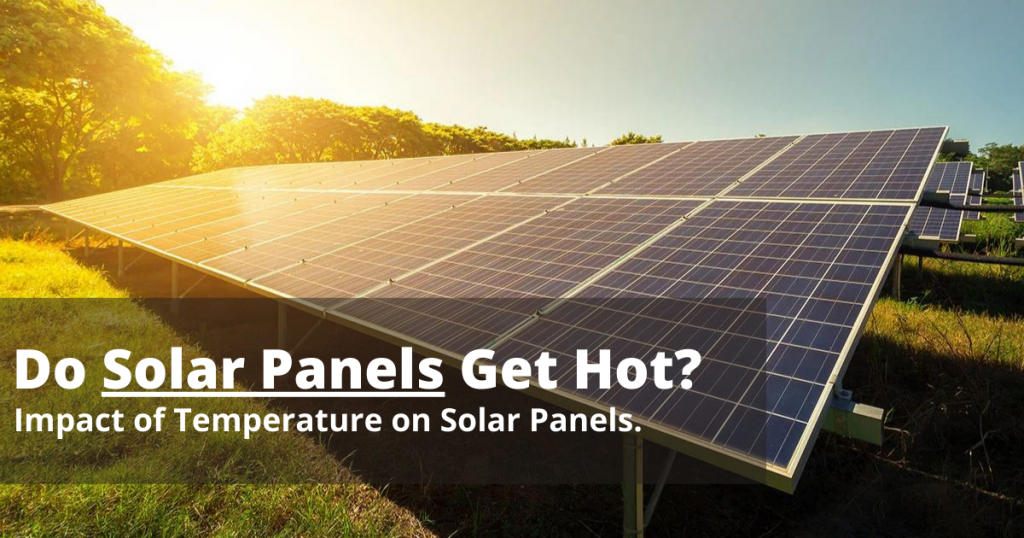Do Solar Panels Get Hot? Impact of Temperature on Solar Panels.

Solar panels are frequently exposed to high temperatures, particularly on long, hot summer days. In this post, we’ll look at how hot weather affects solar panels and how consumers and manufacturers may reduce those effects. Temperature increases have a negative impact on Solar power system efficiency, which may appear counter intuitive.
Photovoltaic modules are tested at a temperature of 25 degrees Celsius (STC) – about 77 degrees Fahrenheit – and heat can lower output efficiency by 10% to 25% depending on where they are installed. The output current of the Solar power system increases exponentially as the temperature of the panel rises, whereas the voltage output decreases linearly. In fact, the voltage drop is so consistent that it may be used to precisely monitor temperature.
Do solar panels get hot?
Yes, and they get hotter as the light shines more and the temperature rises. Sunlight is absorbed by a solar panel, which then transforms it to electricity. However, not all of the absorbed sunlight is converted to power. Instead, some of the absorbed sunlight will be turned to heat, which will heat up the solar panel. Energy output can be hampered by high ambient temperatures. Solar panels, on the other hand, are subjected to temperatures ranging from -40°F to 185°F.
How Temperature Impact Solar Panels Efficiency?
Solar Panels Installations are typically tested at around 77 degrees Fahrenheit and are rated to work at peak efficiency between 59- and 95-degrees Fahrenheit. During the summer, though, solar panels can reach temperatures of 149°F. When the surface temperature of your solar panels rises to this level, the efficiency of your panels may suffer.
Keep in mind, however, that solar panels are composed of extremely robust materials that are designed to survive harsh outdoor circumstances ranging from subzero temperatures in the winter to scorching temperatures in the summer. Furthermore, air temperature, geographic location, quantity of direct sunshine, and roofing material will all influence the actual temperature of your Solar power system.
So, does panel temperature really matter?
Solar power system generate energy from the sun’s light, which is unaffected by hot or cold temperatures. In cold, bright conditions, energy generation is more efficient, whereas in hotter climates, it is less efficient. Solar panels, like all electric appliances, perform better in cooler temperatures.
Also Read- 7 Ways to Save Energy During Summer.
How to Reduce the Effects of Heat?
Following the Solar Panels Installation of the module technology, there are numerous options for reducing the detrimental impacts of high temperatures:
• Place the panels a few inches above the roof to allow convective airflow to cool them.
• To prevent heat absorption, make sure the panels are made of light-colored materials.
• Place components like inverters and combiners behind the array in the shaded area.
Conclusion –
We’ve seen how Solar Panels Installation may become quite heated due to their direct sunshine exposure. However, because this is what they’re meant for, high temperatures are unlikely to harm your solar panels.
High temperatures have varying degrees of impact on the performance of various solar panel models.
- If you reside in a hot climate, solar panels with a low temperature coefficient should be considered. Even at extreme temperatures, these more expensive panels perform admirably.
- If you reside in a milder climate, the temperature coefficient of a solar panel isn’t as relevant, so it shouldn’t be a major consideration when choosing a system.
- For maximum efficiency, keep your solar system as cool as possible, regardless of where you reside. Make sure there’s adequate space between your roof and solar panels, and in hotter climates, consider using water as a cooler.
Get your solar installation done today with top Solar Panels Installer in California.